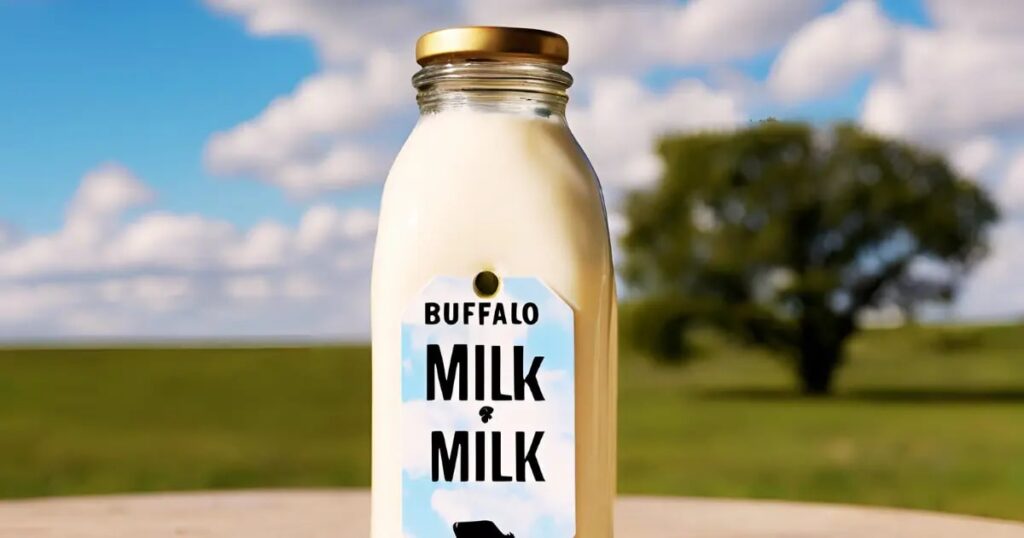Buffalo milk has garnered attention for its rich nutritional profile, creamy texture, and numerous health benefits. The Wellhealthorganic approach emphasizes sustainable, ethical, and organic farming practices, making buffalo milk a standout choice for health-conscious consumers in the USA.
This article explores the unique aspects of buffalo milk, its advantages over other dairy options, and practical tips for incorporating it into daily diets.
Understanding Buffalo Milk:
Buffalo milk, derived from water buffalo, is a staple in various cuisines worldwide. It stands out due to its creamy texture, high fat content, and exceptional nutrient density. With a growing focus on organic and sustainable dairy farming, buffalo milk offers a unique blend of taste and health benefits.
Key Nutritional Components:

- Rich in Protein: Buffalo milk contains higher protein levels compared to cow milk, supporting muscle growth and repair.
- Calcium Powerhouse: It is an excellent source of calcium, promoting strong bones and teeth.
- Healthy Fats: The fat content in buffalo milk contributes to its creamy consistency and provides long-lasting energy.
- Vitamins and Minerals: It contains vital nutrients like Vitamin A, B12, magnesium, and phosphorus.
Read More: Is BioVitta Wellness Legit – A Detailed Analysis!
Benefits of Buffalo Milk:
1. Digestive Health:
Buffalo milk contains a good balance of fats and proteins, which are easier to digest for many individuals. Additionally, the probiotic potential of buffalo milk-based yogurt can aid in maintaining a healthy gut microbiome.
2. Lactose Intolerance Considerations:
While buffalo milk does contain lactose, its composition may be easier to digest for some people with mild lactose intolerance. Lactose-free options are also available for sensitive consumers.
3. Superior Creaminess for Culinary Use:
The higher fat content makes buffalo milk ideal for creating creamy recipes, such as desserts, cheeses, and yogurts.
4. Allergy Considerations:
Buffalo milk is less allergenic for some people compared to cow milk due to differences in protein structures. However, it is essential to consult a healthcare professional if allergies are a concern.
Wellhealthorganic’s Approach to Buffalo Milk:
1. Sustainable Organic Practices:
Wellhealthorganic emphasizes sustainability through:
- Organic Farming: Avoiding harmful pesticides and chemicals ensures clean and natural milk.
- Animal Welfare: Ethical treatment of buffaloes ensures better milk quality.
- Environmental Focus: Employing eco-friendly practices reduces the carbon footprint of dairy farming.
2. Buffalo Milk vs. Other Dairy Options:
| Attribute | Buffalo Milk | Cow Milk | Plant-Based Milks |
| Protein Content | Higher | Moderate | Varies |
| Fat Content | Higher, creamy texture | Lower | Usually low |
| Calcium | Higher | Moderate | Fortified in some types |
| Taste | Rich, creamy | Mild | Varies |
| Sustainability | Moderate (organic focus) | Moderate to High | High |
Culinary Applications of Buffalo Milk:
1. Cheese and Yogurt Varieties:
Buffalo milk is the primary ingredient in mozzarella, burrata, and other gourmet cheeses. It’s also used to create thick, flavorful yogurts.
2. Traditional Recipes:
In many cultures, buffalo milk is used to prepare desserts like kulfi, fudge, and creamy beverages.
3. Modern Recipes:
Incorporating buffalo milk into smoothies, soups, and baked goods adds richness and depth.
Practical Tips for Using Buffalo Milk:
1. Storage and Shelf Life:
- Always store buffalo milk in a cool environment (below 40°F).
- Use airtight containers to maintain freshness.
- Adhere to expiration dates and use pasteurized options for safety.
2. Procuring Buffalo Milk:
- Local Sources: Visit nearby organic farms or farmer’s markets.
- Retail Availability: Look for trusted brands like Wellhealthorganic in local grocery stores.
Health-Conscious Consumer’s Guide to Buffalo Milk:
Buffalo milk has emerged as a favorite for health-conscious consumers due to its rich nutritional value, creamy texture, and numerous health benefits. Whether you’re looking to optimize your diet or explore sustainable food choices, buffalo milk offers something for everyone. Here’s an in-depth guide to making informed decisions about buffalo milk and incorporating it into your lifestyle.
1. Key Considerations When Choosing Buffalo Milk:
When selecting buffalo milk, several factors ensure you’re making a healthy and sustainable choice:
- Nutritional Value: Look for milk with high protein and calcium content. Organic buffalo milk tends to have fewer additives and preservatives.
- Ethical Farming: Support brands or local farms committed to animal welfare and sustainable practices.
- Freshness and Purity: Opt for milk that is pasteurized and free from artificial hormones and antibiotics.
2. Incorporating Buffalo Milk into Diets:
Buffalo milk can be seamlessly integrated into various diets, from high-protein meal plans to low-lactose diets.
- Morning Boost: Add buffalo milk to your coffee or tea for a creamy start to the day.
- Smoothies: Blend it with fruits, nuts, and seeds for a nutrient-packed snack.
- Cooking: Use buffalo milk in soups, sauces, or curries for added richness and flavor.
- Desserts: It’s perfect for making ice cream, panna cotta, and custards due to its creamy consistency.
3. Choosing the Right Dairy for Nutrition Goals:
Buffalo milk stands out for those aiming to:
- Build Muscle: Its high protein content supports muscle repair and growth.
- Strengthen Bones: Rich in calcium and phosphorus, it helps maintain bone density.
- Boost Immunity: Essential vitamins like B12 and A enhance immune function.
Methods of Procuring Buffalo Milk:
1. Local Sources and Farm Visits:
Visit nearby farms that practice organic and sustainable dairy farming. This not only supports local businesses but also ensures you get the freshest product.
2. Retail Availability and Brand Selection:
Buffalo milk is available in many specialty grocery stores and online marketplaces. Look for brands with transparent sourcing and ethical practices.
Storage and Shelf Life of Buffalo Milk:
Proper storage is crucial to preserving the quality and safety of buffalo milk:
- Refrigeration: Always store buffalo milk at or below 40°F.
- Sealed Containers: Use airtight containers to prevent contamination.
- Consumption Timeline: Consume fresh milk within 3-5 days of opening, and always check the expiration date.
1. Preservation Tips for Freshness:
- Freezing: Buffalo milk can be frozen for up to three months. Thaw it in the refrigerator before use.
- Pasteurized Milk: Choose pasteurized milk for a longer shelf life without compromising safety.
2. Understanding Expiration Dates and Safety:
- Sell-By Date: Indicates how long the store can display the milk.
- Best-By Date: Suggests when the milk will be at its peak quality.
- Safety First: If the milk smells sour or develops a thick texture, it’s time to discard it.
Environmental and Economic Impact:
1. Sustainability Aspects:
Buffaloes are resilient animals that can thrive in diverse climates, making buffalo farming a sustainable option. Organic buffalo farming practices significantly reduce greenhouse gas emissions compared to conventional methods.
2. Supporting Local Economies:
In regions where buffalo milk production is prominent, local farmers benefit economically, promoting rural development and job creation.
Processing and Pasteurization:

1. Modern Techniques in Milk Treatment:
- High-Temperature Pasteurization: Destroys harmful bacteria while preserving nutrients.
- Ultra-Pasteurization: Extends shelf life significantly but may slightly alter the taste.
2. Impact of Pasteurization on Nutrients:
While pasteurization eliminates harmful pathogens, it can cause minor nutrient loss. However, the benefits of safety outweigh the minimal reduction in vitamins.
Read More: Discover Ultimate Relaxation at Thai Wellness Dedham!
Are there any known allergens in buffalo milk?
Yes, buffalo milk contains casein and lactose, which are common allergens. People with lactose intolerance or a casein allergy may experience digestive issues or allergic reactions. It’s recommended to consult a healthcare provider before consuming buffalo milk if you have known sensitivities.
Common Uses and Recipes for Buffalo Milk:
Buffalo milk is a versatile ingredient in both traditional and modern recipes:
- Traditional Dairy Practices: Cultures worldwide use buffalo milk to make ghee, paneer, and yogurt.
- Modern Dishes: Add it to smoothies, pasta sauces, and baked goods for a creamy texture.
1. Cheese and Yogurt:
Buffalo milk is the base for mozzarella, ricotta, and thick, creamy yogurt varieties.
2. Desserts:
Its rich fat content is perfect for making desserts like kulfi, gelato, and pudding.
Scientific Studies on Buffalo Milk:
Several studies highlight buffalo milk’s benefits:
- Nutritional Superiority: Research confirms its higher protein, calcium, and fat content compared to cow milk.
- Digestive Health: Studies suggest its unique fat globule structure aids digestion.
- Lower Cholesterol: Buffalo milk contains less cholesterol, making it a heart-healthy choice.
Buffalo milk is also gaining attention for its potential use in nutraceuticals and functional foods due to its high nutrient density.
FAQ’s:
1. Can lactose-intolerant individuals consume buffalo milk?
While not lactose-free, buffalo milk’s protein structure may make it easier to digest for some individuals with mild lactose intolerance.
2. How does buffalo milk compare to cow milk in terms of fat content?
Buffalo milk has higher fat content, giving it a creamier texture and making it ideal for dairy-based recipes.
3. What are the best ways to store buffalo milk?
Refrigerate buffalo milk at or below 40°F in airtight containers and consume it within the recommended expiration period.
4. Is buffalo milk suitable for making cheese and yogurt?
Yes, buffalo milk is preferred for mozzarella cheese and creamy yogurt due to its rich texture and high-fat content.
5. Can buffalo milk help with weight management?
Its high protein content promotes satiety, potentially aiding in weight management when consumed in moderation.
6. Where can I buy buffalo milk in the USA?
Buffalo milk is available at select organic farms, specialty grocery stores, and online retailers offering Wellhealthorganic products.
7. How does pasteurization affect buffalo milk?
Pasteurization ensures the milk is safe to consume by eliminating harmful bacteria while preserving most nutrients.
Closing Thoughts:
The Wellhealthorganic Buffalo Milk Tag represents more than a dairy product—it reflects a commitment to health, sustainability, and ethical practices. Buffalo milk is a nutritious, versatile choice for individuals seeking to enhance their diets while supporting responsible farming. By choosing buffalo milk, you embrace a healthier lifestyle and contribute to a more sustainable future.
Read More: